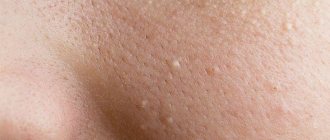A wide variety of neoplasms can appear on a person’s skin throughout his life. Often these are just moles, which some consider a kind of decoration, and sometimes papillomas, warts, dry calluses. Hanging moles, medically called nevi, are somewhat different from other neoplasms. You should be especially careful with them, as they are capable of degenerating into a cancerous tumor.
Reasons for appearance
Hanging nevi look like cone-shaped growths with an uneven surface. The color may vary, but in most cases it is close to skin tones. Often the growths merge with the skin, and sometimes have a white or even brown tint.
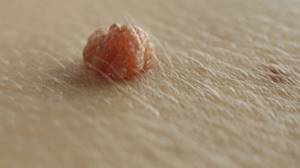
The formation of this type of moles occurs at different periods of life, for example, in children they appear during puberty, and in women - during pregnancy due to fluctuations in hormone levels. Hanging nevi have different morphologies and locations. They often appear on visible parts of the body, are characterized by an unaesthetic appearance and provoke the emergence of complexes. The number of such formations usually increases with age.
The main reasons for the appearance of hanging moles on the body:
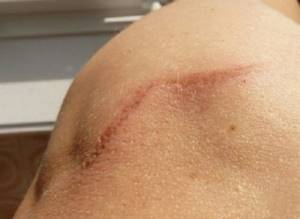
- Genetic predisposition. If at least one of the parents has a large number of such neoplasms, then with a 90% probability the child will also have a lot of them. They do not pose a serious threat to health, but nevertheless require careful monitoring.
- Ultraviolet radiation. Typically, the number of moles begins to increase when the skin is exposed to sunlight. Ultraviolet light changes the composition of cells and provokes excessive production of melanin. Large doses of radiation received, for example, in a solarium, contribute to an even greater appearance of melanin formations. People with fair skin, red hair and light eyes should be wary of such exposure.
- Hormonal imbalances. A decrease or increase in hormone levels affects the production of melanin and causes the growth of moles of this type.
- Skin damage. Burns, insect bites, scratches and other injuries significantly increase the risk of neoplasms.
- Infection with human papillomavirus. Infection can cause multiple formations on the skin, which, if left untreated, quite often degenerate into cancer.
- Stressful situations and emotional outbursts. As a rule, after psychological disorders, a surge of adrenaline occurs, which disrupts metabolic processes in the epidermis.
- Radiation. The occurrence of nevi is associated with the body’s protective reaction to increased melanin production. Observed when working with radioactive substances.
Formations that appear during pregnancy tend to disappear spontaneously. They disappear when the hormonal levels are completely restored after the birth of the child.
Pigmented formation on the skin can be found in almost all people, regardless of age, race or gender. If such elements appear, you should consult a dermatologist. It will help eliminate the risk of the nevus degenerating into a cancerous tumor.
What it is
Hanging moles are a tumor that develops from epithelial cells. Outwardly, they look like small papillae hanging from the skin. These nevi are lumpy and heterogeneous. Their hue is often the same as their epidermal color, but can also be brown. They can appear on any part of a person’s body, regardless of his age category. For the most part, they pose no danger.
But this does not mean that consultation with a dermatologist can be neglected. Hanging nevi can develop into a malignant neoplasm.
If the doctor does not diagnose the mole with a dermatoscope, a harmful process can start without timely treatment.
Locations
Small hanging tumors can be located on any part of the surface of the body, but in most cases they are localized in the armpit, neck and genital area. This is due to the fact that in these areas the skin is quite thin and is subject to friction, which contributes to the accumulation of pigmentation cells.
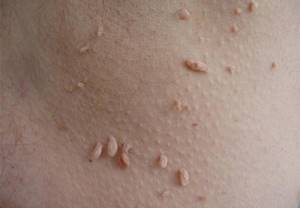
Moles in the armpits form in the area of the sweat glands . Excessive sweating negatively affects the nevus, especially when it is damaged. Moles growing in this area interfere with personal hygiene because they force you to be patient when shaving your hair. In most cases, a decision is made to get rid of such tumors.
On the surface of the skin in the breast area in women, you can notice many small pigmented growths. They often appear as a result of strong exposure to sunlight. Pregnancy or its interruption is considered to be a factor in the occurrence of nevi. This leads to hormonal imbalance and leaves a large number of tumors in the décolleté area.
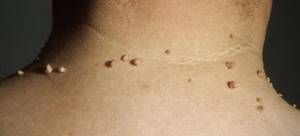
Nevi of this type on the neck are almost always exposed to excessive ultraviolet radiation and are often injured by nails or rubbed against clothing. The reasons why hanging moles appear on the neck are also genetic in nature and are also related to the physiological characteristics of the patient. If a formation bothers a person, sometimes it bleeds or hurts, it is better to choose a safe way to remove it.
Convex elements on the skin often appear in the perineum. As a rule, they cause psychological discomfort and can interfere with the hair removal process. Any cosmetic procedures related to this area should be previously discussed with a dermatologist. An experienced doctor will advise you on how to get rid of skin growths. Today, many methods have been developed for removing hanging moles, which are effective and painless.
Summary or briefly about the main thing:
If your mole has enlarged, wait a minute to sound the alarm. First, answer the question: does the mole grow faster than 1-2 mm per year? If the rate is not higher than indicated and there are no other symptoms of melanoma (“geographical” edge, asymmetry along two axes, bleeding without injury, etc.), then most likely everything is fine with the mole. At the same time, if there is even the slightest doubt about the correctness of your conclusions, the oncologist should say the last word during an in-person examination.
If you still have questions, the following will help you:
- In-person appointment with an oncologist
(St. Petersburg) - Mole removal
with histology (St. Petersburg) - My online consultation (from anywhere in the world)
Other articles:
- Is a black mole a sign of melanoma?
- Why does hair grow on a mole?
- Are moles with uneven coloring dangerous?
- Is sunbathing dangerous to life? Truth and fiction
Useful article? Repost on your social network!
The danger of nevi
Any changes that have occurred in the body of the mole should cause certain concerns. Like any nevi, pendulous lesions on the skin are considered a benign neoplasm. But if unfavorable factors occur, they can degenerate into an oncological tumor. This usually applies to those moles that are subject to mechanical stress. More often than others, nevi in the armpit area and on the face become inflamed, since they are damaged by shaving. They are also affected by sweat secretions, which are a favorable environment for the growth of bacteria. For this reason, these areas require careful hygiene.
The owner of hanging moles should be wary if one of them turns black, becomes inflamed, or begins to grow. It is necessary to pay extreme attention to the appearance of such signs as:
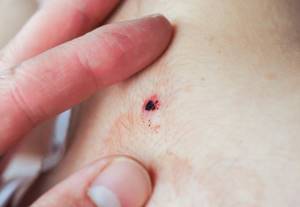
- bleeding from a neoplasm;
- the occurrence of painful and itchy sensations in the area where the nevus is located;
- thickening or peeling of the surface of the mole;
- disappearance of the skin pattern during formation;
- redness of the skin that surrounds the growth;
- hair loss;
- weeping discharge from a mole.
In case of such transformations, you should consult a dermatologist as soon as possible. He will conduct an examination, and if melanoma is suspected, he will refer the tumor for histological analysis and then to an oncologist.
Medical professionals consider nevi of this type to be potentially dangerous and recommend paying close attention to them. If you tear off such a formation, it can cause suppuration and the appearance of dangerous symptoms. Before contacting a doctor, the wound resulting from damage to the nevus must be cauterized with an antiseptic, for example, iodine.
How to distinguish a large mole from melanoma?
Here it is important not to “rely on” only one sign. In the ABCD rule, which, of course, is very important in diagnosing melanoma, there are at least 3 other signs - A
(asymmetry) -
asymmetry
,
B
- (border) -
edge, border
and
C
- (color) -
color
.
All three of these characteristics are assessed only together, and not separately. This means that even if a mole is slightly asymmetrical, but has a smooth edge, is evenly colored and its size does not exceed 5 mm, most likely everything is fine with it. Moreover, there is such a type of moles - dysplastic nevi
, which most often have 2 signs at once - an uneven edge and an asymmetrical shape. However, in the vast majority of cases they are benign.
Removal methods
To find out how to get rid of pigmented growths, you need to visit a specialist. After examination and diagnostic testing, the most appropriate technology will be recommended to the patient.
Regardless of whether the formation needs to be removed due to the risk of developing cancer or it just causes aesthetic discomfort, doctors and cosmetologists practice several methods that will help remove hanging moles:
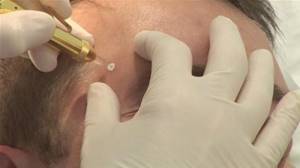
- Surgical excision. This method is relevant for large skin formations that pose a danger. This is a rather painful procedure, which does not exclude the possibility of incomplete removal of the nevus, as well as leaving scars on the skin. The mole may grow back and possibly be even larger. The method allows you to send the tumor material for biopsy to reveal its nature.
- Laser correction is the safest and fastest method of removal, leaving no marks or scars. Allows you to remove nevi on open parts of the body, including the face. This method completely eliminates the occurrence of bleeding and infection. The procedure takes place in stages and has no contraindications. The surface of the growth is successively exposed to a laser, which burns the surface of the mole. A hole remains in place of the mole, which completely disappears after 2 weeks.
- Electrocoagulation. Devices for using this removal technology are available in almost every medical institution. A metal thread is attached to the end of a special handle through which current is supplied. The loop heats up quite quickly and cuts off the stem of the mole. The wound does not bleed, which reduces the risk of inflammation.
- Cryodestruction is a proven method. With its help, large nevi are removed. Through the nozzle of the device, a specialist supplies liquid nitrogen, which freezes the mole. When exposed to low temperatures, it quickly begins to collapse. The main disadvantage of this method is the deep scar on the skin, which can only be eliminated with the help of plastic surgery.
Moles can be present on a person’s body throughout life and not cause any particular inconvenience. But the treatment of such neoplasms must be carried out comprehensively.
It is better not to remove moles while carrying a child. It is necessary to wait until the hormonal balance is restored.
Should I delete it?
Hanging moles can be removed not only for medical reasons. If the neoplasm is an aesthetic defect on the skin, as a result of which a person feels discomfort on a psychological level, many also resort to removal.
From a medical point of view, hanging nevi are removed when a person frequently injures them. Growths on the neck are easily damaged by a narrow neckline, and in the armpit - by depilation using a razor. Such a picture may end with itching, burning, and, worst of all, it becoming malignant in the area of the mole. If the neoplasm has been damaged, it should be treated with hydrogen peroxide and then removed. This will help reduce the likelihood of serious consequences occurring in the future.
Pharmacy products
Before carrying out the procedure, it is recommended to consult with a specialist regarding the use of pharmaceutical products. If nevus removal is carried out at home, it is advisable to do a drug tolerance test . This will prevent the occurrence of allergic reactions. The required amount is applied to the wrist from the inside. If there is no irritation, the drug can be used after some time.
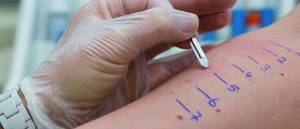
The drug Cryopharma is considered an effective remedy for getting rid of moles. Used to remove benign tumors. The action is comparable to the freezing procedure with liquid nitrogen. The composition is applied to the nevus and held for 15-20 minutes. A blister forms at the site of the mole, which disappears after 10 days along with the neoplasm. There are no scars left on the skin, and after a while, completely healthy tissue forms at the site of formation.
The doctor may recommend the use of a lapis pencil, which contains silver nitrate, which has a disinfecting effect. They lubricate the nevus daily until it dries and falls off on its own.
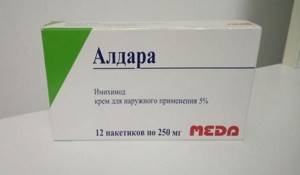
To eliminate skin growths, a topical cream called Aldara is often used. The active ingredient of this drug has a destructive effect on the formation and causes its complete death. During use, a slight inflammatory reaction is possible, which disappears during therapy.
Stefalin ointment is another modern and very effective remedy. It penetrates deeply into the mole and its root, providing a good result. The skin around the growth should be covered with a plaster, since the ointment cannot be applied to other parts of the body. It is used once a day, but it is better to use it before bed or throughout the night. It is not recommended to wet the mole during treatment.
The result of using any pharmaceutical product should be noticeable in the very near future, for example, after the first week of use. At the site where the mole disappears, a small wound always remains for some time. To speed up its healing, you can use creams and ointments that have regenerating properties.
Why can a mole get bigger?
As I have written many times, a mole consists of nevus cells. They are a bit like melanocytes, which are what cause our skin to turn brown after tanning. They, like melanocytes, produce pigment and therefore most moles are brown. Pigment cells divide very rarely, if not almost never divide. However, this can occur under the influence of certain factors. The most studied of these causes are sunlight and pregnancy.
Intense sunlight
is a damaging factor for our skin.
The pigment melanin, which was mentioned above, protects our skin from its negative effects. Sometimes the intensity of production of this substance is not enough for protection and the body gives a signal to divide nevus cells and melanocytes. As a result of this, we may see an increase in our moles and the appearance of new ones.

Read more about sun protection in this article.
Pregnancy.
I will assume that many of the women reading this article have noted the growth of existing moles and the appearance of new ones in this difficult period of life.
The fact is that during pregnancy you can grow a whole new person in 9 months. For tissue growth, hormones are needed, which are secreted by the body in considerable quantities. The child grows, and along with him, the nevus cells of moles also come under the influence of the mother’s hormones. As a result, just like when exposed to sunlight, we can notice the growth of moles and the appearance of new ones
.
In addition to these two factors, there are probably others, however, they are still waiting for their researchers.
Is it dangerous if a mole disappears?

The disappearance of birthmarks indicates changes in the body. It is necessary to monitor not only moles, but also the accompanying symptoms. The best decision would be to consult a specialist and get tested for oncology.
Disappearing nevi are already one of the serious signs of pathology. This can serve as a signal:
- development of melanoma;
- the appearance of the skin disease Vitiligo;
- depigmentation caused by damage or prolonged exposure to the sun.
Even if the loss or discoloration of the growth is caused by a burn, there are still health risks from exposure to ultraviolet light. We need to approach this problem seriously, because the most harmless, but excessive impact on a birthmark can lead to negative consequences.

